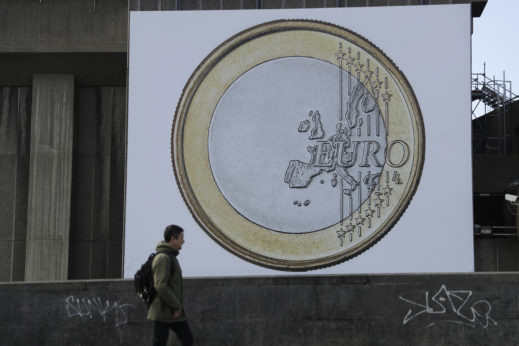
The good news out of Europe is that Marine Le Pen’s neo-Nazi National Front took a beating in the May 7 French presidential election. The bad news is that the program of the winner, Emmanuel Macron, might put Le Pen back in the running six years from now.
Macron pledges to cut 120,000 public jobs, reduce spending by €60 billion, jettison the 35-hour workweek, raise the retirement age, weaken unions’ negotiating strength, and cut corporate taxes. It is a program that is unlikely to revive the morbid French economy, but it will certainly worsen the plight of jobless youth and seniors and hand the National Front ammunition for the 2022 election.
Europe is enmeshed in an economic crisis brought on by the structure of the European Union (EU), on one hand, and the nature of capitalism, on the other. That convergence has derailed economies throughout the 27-member trade group, impoverished tens of millions, and helped conjure up racist, right-wing movements that are not likely to be deterred by a few election losses.
Obscuring the roots of this crisis is the myth that debt is the result of spendthrift behavior, economic sluggishness a consequence of high taxes, and inhibited business growth the payoff of having rigid labor rules. German Chancellor Angela Merkel is fond of saying that countries should behave like a “frugal Swabian house frau.”
Is Merkel’s observation based on a myth, or is it allegory? While an allegory is the “figurative treatment of one subject under the guise of another,” a myth is “an unproven or false collective belief that is used to justify a social institution.” The difference may seem pedantic, however, it is anything but, and, because myths are particularly hard to dislodge, once they become widespread, it is essential to unpack exactly how the EU got itself in trouble.
Capitalism is part of the problem
Part of the problem is capitalism itself, an economic system that generates both enormous productive capacity and economic chaos.
Capitalism is afflicted by two kinds of crises: cyclical and structural. The cyclical ones – recessions – tend to occur pretty much every ten years. The U.S. and Europe went through recessions in the early 1980s, early 1990s, and the first years of the 2000s. They are painful and unpleasant but are generally over in about 18 months.
Every 40 or 50 years, however, there is a structural crisis like the 1929 crash and the ensuing Great Depression.
When a structural crisis hits, capitalism re-organizes itself. In the 1930s, the solution was to create a redistributive capitalism that used the power of the state to prime the economic pump and alleviate some of the chaos that accompanies such re-organizations. In the U.S., unemployment insurance and Social Security took some of the edge off the pain, public works absorbed some of the jobless, and unions got the right to organize and strike.
Capitalism went through another structural crisis at the end of the 1970s, and it is the fallout from that one that currently plagues the EU – and the U.S. Using the 1979-81 recession as a screen, taxes on corporations and the wealthy were slashed, business and finance de-regulated, public institutions privatized, and unions assaulted. Capitalism also went global.
Globalism did spur enormous growth, but with a deep flaw. With unions weakened – in part by direct attack, in part by the enormous pool of cheap labor now available in the developing world – wages either stagnated or fell in Europe and the U.S., and the gap between rich and poor widened. A 2015 study by Oxfam found that 1 percent of humanity now controls over half the world’s wealth, and the top 20 percent owns 94.5 percent. In short, 80 percent of the world gets by on 5.5 percent of the world’s wealth.
This is not just a problem for the developing and underdeveloped world, though. Germany has the biggest economy in the EU, and the fourth largest in the world. In 2000, Germany’s top 20 percent earned 3.5 percent more than the bottom 20 percent. Today, that number has increased five times. For the bottom ten percent, income has actually fallen. While earnings are up six percent, the cost of living has increased 24 percent. If that Swabian house frau was among that ten percent, it didn’t make a whole lot of difference how frugal she was; she was broke.
Globalization generated instability by creating a crisis of accumulation. A few people had lots of money, but far too many had very little, certainly not enough to absorb the output of the global economy. Global capitalism was awash with cash, but where to use it? The answer was financial speculation – especially since many of the restraints and safety measures had been removed through deregulation.
For Europe, most of that speculation went into land. Land prices in Spain and Ireland rose 500 percent from 1999 to 2007. In the case of Ireland, it was almost unreal. Irish real estate loans went from €5 billion in 1999 to €96.2 billion in 2007, or more than half the GDP of the Republic. Over the same period, European household debt increased on the average by 39 percent.
That this was a bubble was obvious and all bubbles pop sooner or later. This one exploded in the U.S. in late 2007 and quickly spread to Europe.
What is important to keep in mind is that the EU countries that got into trouble were hardly spendthrifts. Spain, Portugal, and Ireland all had modest debt ratios and budget surpluses at the time of the crisis.
The problem was not prodigal governments but a sudden hike in borrowing rates, which made it expensive to finance government operations. That was coupled with a decision to use taxpayer money to bail out banks that had gotten themselves in trouble speculating on real estate. Essentially, Portuguese, Spaniards, Greeks, and Irish picked up the debts of banks they had never borrowed anything from.
Irish taxpayers shelled out €30 billion to bailout the Irish-Anglo bank, a figure equivalent to the Republic’s tax revenues for an entire year. Since none of these countries had that kind of money on hand, they applied for “bailouts” from the International Monetary Fund, the European Central Bank, and the European Commission – the so-called “troika.” Some 89 percent of those bailouts went to banks. The day the Greek bailout was announced, French bank shares rose 24 percent.
It was not that EU countries were debt-free, but in 2014, the Committee for a Citizen’s Audit on the Public Debt found that between 60 and 70 percent of those debts were due not to overspending, but instead to tax cuts for corporations and the wealthy and increases in interest rates. The latter favors creditors and speculators. The Committee found that most deficits were the result of “political decisions” that shift the wealth from one class to another.
In the long run, some of that debt will have to be forgiven because it is simply unpayable. The 1952 London Debt Convention that cut Germany’s post-war debt and ignited an economic revival could serve as a template.
The EU’s structural deficit
Converging with this crisis of capitalism is the way the EU is structured, although the two are hardly independent of one another. Many of EU’s strictures were specifically designed to favor capital and finance and to marginalize the control that the Union’s 500 million members have over economic matters.

The first problem is that all economic decisions are made by the “troika,” an unelected body that answers to no one. There is a European Parliament, but it has little power or control over finance. The same is true for EU member governments. When former Greek Finance Minister Yanis Varoufakis told German Finance Minister Wolfgang Wolfgang Schauble that his left-wing Syriza Party was elected to resist the austerity policies of the EU, Schuable replied, “We cannot possibly let an election change anything.”
The second problem is that national governments have no control over the value of the Euro. Of the EU’s 27 members, 19 of them use the common currency and make up the Eurozone. Germany’s condition for giving up the Mark and adopting the Euro was that Eurozone members were required to keep budget deficits to no more than 3 percent of national income and debt levels to no higher than 60 percent of GDP. While that formula works well for Germany’s powerful export model, it doesn’t for of a number of other Eurozone economies.
The Euro’s value is set by the European Central Bank, which means that members cannot devalue their currency, a common strategy for dealing with debt, and one near and dear to the U.S. Treasury. As long as it’s smooth sailing, this rule works, but when a financial crisis hits, the common currency and the debt restrictions can mean big trouble for the smaller, less export-centered economies. When the financial bubble popped in 2008, countries like Italy, Spain, Portugal, and Ireland – and to a certain extent, France – saw their debts soar, with strategies for dealing with it hamstrung by the Eurozone rules.
And that is when the third problem with the Eurozone kicked in. While there is a common currency, there is no sharing of debt through tax receipts. In a single currency system like the U.S., powerful economies in California and New York pay for bills in places like Mississippi and Louisiana.
Some 44 percent of Louisiana’s state budget, for instance, is paid for by the federal government, which collects taxes in wealthy states and doles out some of it to regions whose economies are either too small or inefficient to meet their budget needs. If you get into trouble in the Eurozone, you are on your own.
While the EU has been good for banks and countries like Germany and Austria, it hasn’t been so good for many of its other members. Applying austerity as a cure for debt doesn’t cure the problem, it just creates a spiral of more debt and yet more austerity. As Rana Foroohar, business columnist for the Financial Times put it, “No nation can grow when the consumer, the corporate sector, and the public sector stop spending.”
Center-left: Guilt by association
Because most of the center-left parties bought into the austerity-as-a-cure-for-debt formula, they have been devastated at the polls. The Dutch Labor Party was crushed in the last election, the French Socialists got less than 7 percent of the vote, and the Spanish Socialists are barely keeping ahead of the much more left Podemos Party. The Italian Socialist Party has dropped over 15 points in the polls and is now running behind the rather bizarre Five Star Movement. The Greek Socialists are a footnote.
The lesson for the left would seem to be that moving to the center or the right is a prescription for electoral disaster.
Macron’s new centrist party, En Marche!, won, but mostly due to the anti-Le Pen vote. His program of austerity, restraints on unions, and corporate tax cuts is popular with everyone, although En Marche! did well in the first round of voting for the legislature, and results indicate he may get a majority. If he does not, he plans to push the measures through by decree.
It is unlikely that such a centrist program will do anything to reduce France’s unemployment rate – 9.6 percent overall and 25 percent among youth age 18 to 29 – or lift the economy. Labor “reform” and austerity do not jumpstart economies, and tax cuts have an equally dreary record. Indeed, as Foroohar points out, there is not a single example in the last 20 years where tax cuts for business or the wealthy stimulated an economy. Indeed, the economic surge in the 1990s happened while tax rates were on the rise.
If the economic situation worsens, or even stays the same, the right will be waiting to pounce with their easy answers to economic crisis: nationalism and racism.
The clock is ticking. Germany will hold elections in September, and it looks as if Italy will also go to the polls this fall. In Spain, the right-wing minority government is looking increasingly fragile and another election is a strong possibility.
Center-left parties are doing well in Portugal, where the Socialists have made common cause with two more leftist parties. In Britain, the Labour Party’s sharp break with its past centrism upended the Conservative Party, denying it a majority in Parliament. A recent YouGov poll found that a majority of Britons supported Labour’s left-wing platform over the Conservatives’ austerity program.
The Portuguese coalition is demonstrating that there are successful economic models out there to deal with debt and growth that don’t impoverish the many for the benefit of a few. The question is, can the left in Italy, Spain, and Germany put together programs that tap into the seething unrest that globalism’s inequality has generated?
This article originally appeared at Dispatches from the Edge.










